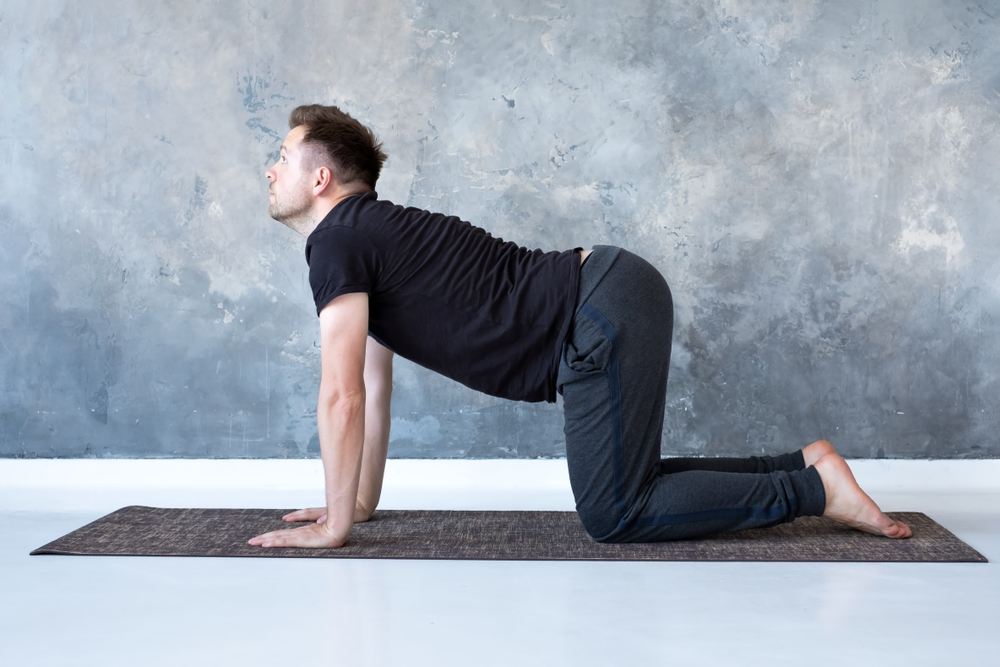Your thoracic spine—the middle part of your back—often gets stiff from long hours of sitting, which can lead to poor posture and discomfort.
The five best stretches to improve its mobility are the Open Book, Thread the Needle, Cat-Cow, Foam Roller Thoracic Extension, and Side-Lying Windmill.
Keep reading for a quick breakdown of how to do each one and when to use them.
Why Thoracic Spine Mobility Matters More Than You Think
You might not think much about the middle section of your back, but your thoracic spine plays a central role in how your body moves and feels throughout the day.
Whether you're reaching for something overhead, sitting at a desk, or just breathing deeply, this part of your spine is doing more work than you realize—and when it’s stiff, you’ll feel it in more places than one.
The Backbone of Posture and Movement
The thoracic spine is made up of 12 vertebrae (T1 to T12) and connects to your ribs, which means it directly supports your upper body and helps maintain good posture.
When it moves well, your shoulders glide easily, your neck stays relaxed, and your lower back doesn't have to overcompensate.
If it’s stiff or locked up, your whole alignment can shift out of balance.
This region is built for rotation and extension, unlike the lower back which favors stability.
That’s why limited mobility here often shows up as tight shoulders, slouching, or even hip and lower back tension—because other areas have to do work they weren’t designed for.
How Stiffness Affects More Than Just Your Back
A rigid thoracic spine does more than just make you feel tight after a long day.
It can quietly affect how you breathe, how you lift, and how much tension builds up in your neck and shoulders.
- Breathing becomes shallower when the rib cage can't expand properly, especially during physical activity or stress. The diaphragm and lungs rely on movement in the thoracic spine to fully function.
- Lifting mechanics break down when the thoracic spine doesn’t extend well. You may lean forward or round your back during overhead movements, which increases the risk of strain or injury.
- Neck and shoulder discomfort rises as those areas start compensating for the lack of upper back movement. Instead of rotating from your thoracic spine, your neck might twist more than it should, creating tension over time.
This isn’t just about athletic performance—it’s about daily comfort.
Everything from reaching a top shelf to turning your head while driving can become harder or more painful if your thoracic spine doesn’t move well.
What Regular Mobility Work Can Really Do
Adding just a few thoracic-focused stretches into your routine can make a noticeable difference.
If you sit a lot—whether at work, during a commute, or just relaxing—your thoracic spine naturally settles into a rounded, inactive position.
Mobility work reintroduces movement where it’s been lost and supports better alignment overall.
Over time, consistent stretching can:
- Help your spine return to a more upright position, improving posture without forcing it.
- Increase comfort during everyday tasks like driving, typing, or carrying things.
- Support better performance during workouts by allowing full-body movements to happen more efficiently.
- Reduce the frequency of nagging neck and shoulder tightness, especially for people who work at a computer all day.
It’s not about dramatic changes overnight—it’s about gradual improvements that add up.
Think of thoracic mobility as maintenance, not a fix.
When you keep it moving, the rest of your body works better, too.
Open Book Stretch
This stretch is a simple yet highly effective way to restore rotation through the mid-back—the section that often tightens up from too much sitting.
The Open Book Stretch specifically targets the thoracic spine by rotating the upper body while keeping the lower body stable, helping to unlock stiffness without straining surrounding muscles.
Why It Works
- Encourages controlled thoracic rotation without overextending the lumbar spine.
- Mobilizes tight muscles between the shoulder blades and along the spine.
- Reinforces spinal separation—movement in the upper spine while the lower remains fixed.
How to Do It
- Lie on your side with both knees bent at 90 degrees. Stack your legs one on top of the other to create a stable base.
- Extend both arms straight in front of you at shoulder height, palms together.
- Slowly rotate your top arm away from the bottom, opening your chest toward the ceiling. Let your head follow the motion of your hand.
- Keep your knees pressed together throughout—this locks in the lower body so the movement stays in the thoracic spine.
- Pause briefly at the open position, then return to the start with control.
- Repeat 10 times per side.
Pro Tip: If your knees start to separate during the movement, reduce your range slightly. The goal isn’t how far you open—it's how well you isolate the upper back.
When to Use It
This stretch fits perfectly into:
- Post-work routines to counteract hours of slouched sitting.
- Evening wind-downs as a low-effort mobility reset.
- Pre-bedtime routines to ease upper body tension before sleep.
Its simplicity and high payoff make it one of the most accessible ways to improve thoracic mobility with minimal time or space required.
Thread the Needle
Thread the Needle is a go-to movement for releasing built-up tension in the upper back and shoulders, especially after repetitive or static upper-body activity.
It promotes passive thoracic rotation by letting gravity assist the stretch, which makes it easier on your muscles and joints while still highly effective.
Why It’s Effective
- Targets the upper thoracic region and the space between the shoulder blades—common areas for desk-related tightness.
- Gently stretches the posterior deltoid and mid-back without engaging additional muscle tension.
- Head and arm placement allow for a passive, gravity-assisted twist, minimizing strain.
How to Do It
- Start on all fours in a tabletop position—shoulders stacked over wrists, hips over knees.
- Take your right arm and slide it underneath your left arm, palm facing up.
- Let your right shoulder and the side of your head gently rest on the floor.
- Allow your upper body to rotate naturally while keeping your hips stable.
- Hold for a few seconds, breathing deeply into your upper back.
- Return to the starting position and switch sides.
- Repeat 4–5 times per side.
Tips for Best Results:
- Keep the supporting hand (the one that doesn’t thread) active by pressing lightly into the ground. This adds mild tension and helps control the twist.
- If your head doesn’t comfortably reach the floor, use a yoga block or folded towel for support.
When to Use It
This stretch is especially helpful:
- Midday, as a break from long sitting sessions or screen time.
- Post-workout, to unwind tension built during pushing or pulling exercises.
- During cool-downs, as part of a broader mobility or yoga session.
Because it combines upper body relaxation with spinal rotation, Thread the Needle is one of the most efficient ways to restore upper back movement with minimal effort.
Cat-Cow Stretch

The Cat-Cow Stretch is one of the simplest and most effective ways to restore movement through the thoracic spine by promoting both flexion and extension.
While many thoracic stretches focus on rotation, this one targets forward and backward spinal motion, which is just as critical—especially for improving posture and reducing stiffness from static positions.
Why It’s Valuable
- Encourages mobility in both directions—spinal rounding (flexion) and arching (extension)—which helps counteract the rigid, forward-leaning posture that builds up over time.
- Engages key stabilizing muscles in the upper back and shoulders, making it a useful neuromuscular reset.
- Helps improve spinal awareness, making it easier to activate the thoracic region intentionally during other movements.
How to Perform It Correctly
- Start in a tabletop position with hands under shoulders and knees under hips.
- Inhale as you drop your belly, lift your chest, and tilt your tailbone upward (Cow Pose).
- Exhale as you round your back, tuck your chin, and draw your belly toward your spine (Cat Pose).
- Move slowly and smoothly between these positions, syncing each motion with your breath.
- Complete 5–8 slow, controlled repetitions.
Breathing = Movement
The breathing component is not just supportive—it’s essential.
Deep inhales help open the chest and create space through the front of the spine, while full exhales promote deeper rounding and tension release in the back.
This rhythm can also have a calming effect on the nervous system, making Cat-Cow an excellent stretch for stress relief.
When to Use It
- Morning routines: A great way to wake up the spine and start the day with movement.
- Gentle warm-ups: Prepares the body for more dynamic stretches or strength work.
- Recovery days: A low-impact option for keeping the spine moving without added load.
Cat-Cow may seem basic, but its benefits are foundational.
For anyone spending hours in a fixed position, it’s a smart, easy way to reintroduce dynamic motion through the thoracic spine without overcomplicating things.
Foam Roller Thoracic Extension
Foam Roller Thoracic Extension is a go-to mobility drill for reversing the effects of a rounded, slouched posture.
It specifically targets thoracic extension—something that’s often restricted after long hours of sitting or working at a screen.
Rather than stretching muscles directly, it encourages spinal decompression and segmental movement, helping the vertebrae of the upper back regain motion.
Why It’s Effective
- Promotes spinal extension in a region that often becomes rigid due to forward-leaning posture.
- Helps reduce the “hunched” feeling by re-opening the chest and allowing the upper spine to move more freely.
- Encourages postural realignment by shifting the spine out of prolonged flexion (rounded position).
- Aids in spinal decompression—creating space between the vertebrae, which can help relieve stiffness and discomfort.
How to Do It
- Place a foam roller horizontally on the ground.
- Sit just in front of it, then lie back so it rests under your upper back (mid-thoracic area).
- Support your head with your hands to keep your neck relaxed.
- Gently extend your upper back over the roller by letting your head and shoulders move backward.
- Pause for a few seconds at the end range, then return to neutral with control.
- Repeat 3–4 times, moving the roller slightly up or down to target different thoracic segments.
Tips for Better Results:
- Avoid overarching the lower back—keep your core engaged to isolate the movement in the thoracic region.
- Keep the motion small and controlled; this is about quality of extension, not forcing a big arch.
When to Use It
- After long workdays: Especially useful if you've been hunched over a screen.
- Before bed: Helps relax the upper body and release tension built up throughout the day.
- Post-workout: A great way to reset after weightlifting, overhead work, or intense training sessions.
This stretch doesn’t require much time or effort but can significantly improve how your upper back moves and feels—especially when done consistently.
Side-Lying Windmill
The Side-Lying Windmill is a dynamic thoracic mobility drill that combines both rotation and extension in one continuous, controlled movement.
What makes it especially effective is the wide range of motion it demands, making it more challenging than static stretches while still staying joint-friendly.
Why It Stands Out
- Encourages multi-directional thoracic movement by combining spinal rotation with gentle extension.
- Stretches across the chest, rib cage, and spine, promoting better overall upper-body mobility.
- Because of the large circular path, it engages more tissue and challenges control through a broader range than simpler rotational drills.
How to Perform It
- Lie on your side with hips and knees bent at 90 degrees. Keep your knees stacked to stabilize your lower body.
- Extend both arms straight in front of you, palms together.
- Slowly begin to sweep your top arm in a wide arc—up overhead and all the way behind you—tracing a full circle.
- Let your eyes follow your moving hand to encourage spinal rotation.
- Keep your knees in contact with the floor throughout to isolate the motion to the thoracic spine.
- Complete the circle and return to the starting position with control.
- Repeat 6–8 times on each side.
Pro Tip: Move slowly and stay aware of any areas that feel sticky or restricted. The goal isn’t speed—it’s control and full-range motion.
When to Use It
- Before workouts: A smart addition to pre-activity warm-ups, especially for sports or lifts involving upper-body movement.
- On recovery days: Helps restore motion without placing stress on the joints.
- Weekend mobility resets: Ideal for Sunday sessions when you're winding down and prepping for the week ahead.
Because it targets such a wide range of thoracic motion in a single movement, the Windmill is a high-value stretch that delivers noticeable improvements with just a few reps.
Tips to Maximize Results with These Stretches
Getting the most out of thoracic spine stretches isn’t about pushing harder—it’s about showing up consistently and moving with intention.
These stretches are low-impact by design, but when done right, they deliver big returns in posture, comfort, and overall mobility.
- Make consistency your priority.
Doing these stretches a few times a week is good—but daily is better. Your thoracic spine responds best to regular movement, even if it’s just 5 minutes at a time. - Use your breath to unlock deeper mobility.
Deep, focused breathing helps open the rib cage and release tension from the upper back. Inhale during expansion movements (like opening or arching), and exhale as you round or rotate. - Slow down the pace.
Rushing through reps turns them into mechanical motions with little benefit. Control the movement, feel the rotation or extension, and allow your body time to adapt. - Spread stretching throughout the day.
If possible, break up long periods of stillness by fitting in 1–2 stretches at different times—morning, mid-day, and evening. This approach keeps your thoracic spine moving instead of locking into one posture.
Approach these movements as part of a long-term strategy, not a one-time fix.
Over time, that steady, thoughtful effort will help your thoracic spine stay mobile, resilient, and better aligned with how you move through your day.
Conclusion
Improving thoracic spine mobility doesn’t require complicated routines—just a few consistent, targeted stretches.
Each movement covered here supports better posture, less tension, and more freedom in everyday motion.
Add them to your routine and stay ahead of stiffness before it builds.







